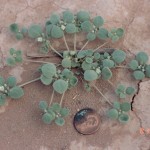Inkweed, Thickleaf Drymary , Thick-leaf Drymary
Drymaria pachyphylla
Caryophyllaceae
Description
Inkweed is a smooth, hairless, short-lived annual with blunt pointed, circular leaves usually about as wide as they are long. The plant grows close to the ground in a circular pattern of 5 to 10 inches or 12.7 to 25 cm in diameter. Stems are nearly prostrate and range from 4 to 8 inches or 10 to 20 cm in length. Small, white flowers are produced in the leaf axils. Bloom time occurs from March to August. Seeds are olive green to black in color and teardrop shaped.Habitat
Inkweed grows on sites with sparse vegetation, most often on heavy, alkaline clay soils and in low areas subject to occasional flooding. Habitats include saline soils, desert flats, river bottoms, and playa margins. It is generally not locally abundant except on disturbed sites. Inkweed is found in western Texas, southern New Mexico, west to southeastern Arizona, and south into Mexico.Toxic Agent
The plant poisons cattle, sheep, and goats. Its toxic agent is unknown. All parts of dry and green plants are toxic. Most poisoning occurs on overgrazed ranges. Plants are most often grazed in the early part of the day when they are swollen with water and more upright. Feeding experiments have shown that a lethal dose is 0.6 percent of body weight for a sheep, 0.4 percent for a cow, and 0.9 percent for a goat.Signs of Livestock Ingestion
Signs appear 18 to 24 hours after a toxic dose is ingested. Death usually occurs less than 2 hours after the first clinical signs occur. Signs appear in this order: Loss of appetite; Diarrhea; Arched back and tucked up abdomen; Coma; Death.Management Strategies
Inkweed is very unpalatable to all classes of livestock. Poisoning generally occurs only when other forage is limited. Range management practices that improve range conditions and increase forage diversity help reduce losses to inkweed. Take special caution in drought years.Images
Plant Characteristics
Flower Color: White
Seed Type: Fruit/Berry
Duration: Annual
Stem Texture: Hairless/Smooth
Growth Habit: Forbs/Broadleaf
Leaf Shape
 : Simple with Pinnate or Parallel Venation
: Simple with Pinnate or Parallel Venation
Season: Warm
Distribution
 : 10 - Trans-Pecos
: 10 - Trans-Pecos
Distributions
Distribution refers to the ecological region in Texas that a plant has been found. You can also view a clickable map.
Book: Toxic Plants of Texas (B-6105)
Collection: Toxics
Livestock Affected: Cattle, Goats, Sheep
Livestock Signs: Anorexia, Arched Back, Coma, Depression/ Weakness, Diarrhea, Restlessness



